Apply with Scoir
Applicant resources
For Students: How to Apply Coalition with Scoir
For Non Scoir High School/International/Transfer Students: How many recommendations do I need?
Requesting Recommendations If Your School Does Not Use Scoir
For Non Scoir High School, International, and Transfer Students: Requesting transcripts, application documents, & letters of recommendation
Colleges resources
For Colleges: Scoir application integration checklist
For Colleges: Configuring your application
For Colleges: Application activation
For Colleges: Importing School Reference IDs
For Colleges: Testing your application
Recommender & supporter resources
Counselors
Getting started
For Counselors: Managing your account
Counselor Dashboard Overview
For Counselors/Teachers: Changing your email address
For Counselors: Creating a Demo Student Account
Using Scoir: A quick start guide for middle school counselors
Adding & managing students
For Counselors: Student roster overview
For Counselors: Add a new student
For Counselors: Student registration process
For Counselors: Labels overview
For Counselors: My student has a Scoir account but I can't see their data
For Counselors: Edit student profiles
For Counselors: Student transferring high schools
For Counselors: Archiving or Deleting Students in Scoir
For Counselors: Recording scholarships and awards for students
For Counselors: Create and manage Saved Views
Managing parents
For Counselors: Using the Parent Roster
Why can't parents see Scattergrams, Surveys, and other Scoir features?
College & career planning
Common App™ in Scoir
Counselors: Using Scoir with Common App
Counselors: Managing Fee Waivers for Common App
Counselors: Managing Common App Early Decision (ED) Agreements in Scoir
Scoir + Common App Integration – FAQ
For Counselors: Viewing students’ career interests
For Counselors: PrinciplesYou character assessment overview
For Counselors: Searching and filtering colleges
For Counselors: Suggesting colleges
For Counselors: Add a college to a student's college list
For Counselors: Manage colleges on behalf of a student
For Counselors: How to view a student's college list in table layout
For Counselors: Managing and using Scattergrams
For Counselors: Understanding List Scores
For Counselors: College Selectivity Levels & Student Match Levels overview
For Counselors: A guide to Predictive Chances with Scoir AI
For Counselors: Guide to Acceptance Likelihood and Intelligent Match
For Counselors: Set student outcomes and post-graduate plans
For Counselors: Discover Programs
For Counselors: Applications Overview
For Counselors: Admission Intelligence FAQ
Document management
School Drive & student Drives
Choosing the right way to share resources with students
For Counselors: Using School Drive
For Counselors: View and manage your student's Drive
For Counselors: Bulk add files & links to students' Drives
For Counselors: Adding a YouTube video to My Drive
Document preparation & uploading
For Counselors: Manage application materials
Counselors: Create a Secondary School Report (SSR) for Individual Students
Counselors: Midyear Reports and Transcripts
For Counselors: Final Reports and Transcripts
For Counselors: Grade Reports (Individual)
For Counselors: Application Fee Waivers
For Counselors: Digitally Signing Early Decision Contracts/Agreements
For Counselors: Completing second Early Decision contract for the same student
For Counselors: A Guide to Letters of Recommendation in Scoir
Counselors: Complete a counselor evaluation/recommendation
Counselors: Checking the status of teacher recommendation requests
Counselors: Uploading recommendations on Behalf of Others
For Counselors: Managing FERPA on behalf of a student
Understanding FERPA - Frequently asked questions
Document sending
Counselors: Bulk Sending Application Documents
For Counselors: Sending Application Documents for individual students
For Counselors: Understanding what "Complete Packets Ready to Send" means
For Counselors: Understanding the "Needs Attention" document status
For Counselors: Cancel sent documents - the send docs "undo" button 😮
For Counselors: Resending an updated transcript after it was already sent
For Counselors: Why aren't documents appearing in the list to be sent to colleges?
Tracking & troubleshooting
Assignments & surveys
For Counselors: Using Plans
For Counselors: Create and assign Tasks
For Counselors: Using Forms
For Counselors: Creating, publishing, and editing Surveys
For Counselors: Viewing Survey results
For Counselors: How do students and parents know that a survey was sent?
For Counselors: Creating brag sheets in Scoir
Uploading test scores & other data
Test Score Imports: ACT score imports
Test Score Imports: ACT and PreACT scores via rapid manual entry
Uploading College Board test scores
Manually adding TOEFL scores for each student
For Counselors: Importing Custom Properties
Bulk add/update Grade Report
Bulk add/update Senior Courses
Bulk add/update Student GPAs
Bulk add/update Transcripts
Reporting
For Counselors: Running reports on student data
For Counselors: Exporting reports from student roster view
For Counselors: Custom Properties and Property Groups
Communication & notifications
For Counselors: Messaging students & parents in Scoir
For Counselors: The Email Center
For Counselors: Sending and scheduling emails
For Counselors: Emailing users using the advanced email integration
For Counselors: Scoir Library & Email Subscription management
For Counselors: What notifications will students receive from Scoir?
For Counselors: Notifications & alerts
Calendar & scheduling
Using the calendar
For Counselors: Calendar overview
For Counselors: Linking your Scoir calendar to an external calendar
Visits & office hours
For Counselors: Scheduling in-person visits & availability
For Counselors: Scheduling virtual visits
For Counselors: Scheduling visits for non-college organizations
For Counselors: Scheduling multiple college visits within the same time slot
For Counselors: Students' notification of college visits
For Counselors: Understanding Scoir RSVP dates
For Counselors: Scheduling office hours
For Counselors: Office hours from the student perspective
For Counselors: Edit or delete a visit
Resources & checklists
Students
Account setup & management
For Students: Scoir student overview
For Students: Creating an account when invited by your high school
For Students: Creating an account on your own (non-Scoir high school student account)
For Students: How to tell if you are linked to a high school or not
For Students: Invite a parent or guardian to Scoir
For Students: What to do if you have multiple accounts
Students: Link your existing Scoir account to a high school
For Students: Change your email or add a backup email
For Students: Delete your account
Build your student profile
For Students: Update your personal information
For Students: First generation students
Students: How to Access and Sign Your FERPA in Scoir
For Students: Edit Your Academic Info (School, GPA, and Test Scores)
For Students: Record your activities and achievements
For Students: Create and export a resume
For Students: Using your Drive
Explore careers
For Students: Taking a career interest assessment
For Students: Taking the PrinciplesYou character assessment
For Students: Discover careers
For Students: Managing careers in your profile
For Students & Parents: Access College Guidance Network with single sign-on (SSO)
College planning
Explore colleges
For Students: Setting your college preferences
For Students: Student interest categories
For Students: Discover colleges
For Students: College profiles
For Students: Comparing colleges
For Students: Viewing Scattergrams
For Students: Discover Events
For Students: Discover Programs
Build & manage your college list
For Students: Understanding what it means to follow a college in Scoir
For Students: My Colleges
For Students: View your college list in a table layout
For Students & Parents: Create and Manage Views
The Balanced List Score
For Students: View & simulate your Predictive Chances for college admissions
For Students: Updating outcomes and post graduate plans
Students: How to Sign your FERPA in Common App
Application documents & resources
For Students: Understanding Test Optional, Test Free & Test Required SAT/ACT Scores
Students: Requesting a Fee Waiver in Scoir
For Students: Early Decision Contracts in Scoir
For Scoir connected students: Requesting transcripts
Students: Requesting Teacher Recommendations if Your School Uses Scoir
For Students: Checklist for ensuring application document delivery
Students: Using Scoir & Common App if Your School Doesn't Connect Them
Students: Requesting Fee Waivers for Common App
Students: Completing an Early Decision (ED) Agreement for Common App
Students: Getting Started with Scoir & Common App
Students: Connecting Common App & Scoir
Assignments
Office hours & visits
Scoir mobile app
College Admissions
Staff setup & management
For Colleges: Add & invite admissions staff
For Colleges: Admissions Officer Roles & Permissions
For Colleges: Remove admissions staff
Integrating Slate with Scoir
Integrating Slate with Scoir
Step 1: Prepare Slate for Scoir Documents and Record Creation
Step 2: Connect Slate and Scoir
Step 3: Map Scoir Student Data and Documents in Slate
For Colleges: Troubleshooting Slate integration with Scoir
Colleges: Scoir Audience Integration with Slate
Applications & documents
Application rounds & requirements
Understanding Application Rounds in Scoir
Creating Application Document Requirements
Creating an Application Deadline
For Colleges: Editing, copying, and deleting Application Requirements
Receiving documents
For Colleges: Scoir Index File
For Colleges: Set up SFTP integration to recieve documents from Scoir
For Colleges: Troubleshoot configuration of SFTP integration with Scoir
For Colleges: Slate Mapping
For Colleges: Supported Document Types
For Non-Slate Colleges: Configuring File Preferences
For Colleges: Downloading & reviewing documents
For Colleges: Grade Reports
For Colleges: The Scoir CSV/Manifest file
For Colleges: How to access student application documents in Scoir
Managing college profile content
For Colleges: Premium Presence overview
Colleges: Create & manage Posts, Events, and Programs
For Colleges: Events
For Colleges: Programs
For Colleges: Guidelines for college profile header photos
Student & guardian messaging
For Colleges: Outreach Messaging overview
For Colleges: Create one-time messages
For Colleges: Create automated messages
Explore high schools & schedule visits
Data insights
District Administrators
For District Admins: Logging into your Network account
For District Admins: Getting started with a Network account
For District Admins: Adding and managing users in your Network account
For District Admins: Network roles and permissions
For District Admins: District communications
For District Admins: Setting up and enabling Advanced Email features
School Administrators
School account setup: Data requirements
Grades 9-12
Grades 9-12: Scoir data gathering instructions (Naviance & SIS for students, parents, and teachers)
Grades 9-12: Scoir data gathering instructions (Naviance, ClassLink & SIS for parents)
Grades 9-12: Scoir data gathering instructions (Naviance, Clever & SIS for parents)
Grades 9-12: Scoir data gathering instructions (ClassLink & SIS for parents)
Grades 9-12: Scoir data gathering instructions (Clever & SIS for parents)
Grades 9-12: Exporting data from your Student Information System (SIS)
Grades 6-8
Grades 6-8: Exporting data from your Student Information System (SIS)
Grades 6-8: Scoir data gathering instructions for account setup (Clever)
Grades 6-8: Scoir data gathering instructions for account setup (ClassLink)
Grades 6-12
Grades 6-12: Scoir data gathering instructions (ClassLink & SIS for parents)
Grades 6-12: Scoir data gathering instructions (Clever & SIS for parents)
Grades 6-12: Scoir data gathering instructions (Naviance, ClassLink & SIS for parents)
Grades 6-12: Scoir data gathering instructions (Naviance & SIS for students, parents, and teachers)
Grades 6-12: Exporting data from your Student Information System (SIS)
Grades 6-12: Scoir data gathering instructions (Naviance, Clever & SIS for parents)
System-Specific Instructions
School account settings
School Settings Overview
Enable application materials (Documents)
Setting your high school student email domain
Setting up and enabling Advanced Email
Ensuring Scoir access and emails will be delivered
Request a GPA scale change
Display school photos for students on their profile
Set Up Your School Reports Template
Managing Student Transcript Settings
Configuring FERPA Waiver & Release Forms
Managing Recommendation Settings
School logo and template for teacher recommendations
Student self-reporting for GPA and test scores
Pending Acknowledgement
Predictive Chances and Scattergram display settings
For Counselors: Overriding a college's application document requirements
Can counselors control who sees Balanced List scores?
Can counselors adjust Balanced List minimums?
Can Balanced List Scores be based on just colleges marked as Applying and Applied?
User setup & roles
Users page overview
Adding and removing counselors and other staff to Scoir
Inviting faculty and staff
Understanding and assigning roles and permissions
Inviting Students
Assigning counselors to students
Inviting parents or guardians
Inform students, families, and staff about Scoir with these templates
Data uploads
Parents
Account setup & management
Parents/Guardians: Managing your email notifications
For Parents/Guardians: Changing your email address
For Parents & Guardians: Getting to Know Your Dashboard
For Parents: How to create and link your account to your student and their school
For Parents/Guardians: Change your Scoir password
Supporting your students
For Parents/Guardians: View your student’s college list
For Parents: View your student’s college list in a table layout
For Parents/Guardians: Suggesting colleges to your student
For Parents/Guardians: Unsuggesting a college for my student
For Parents/Guardians: View and simulate your student’s Predictive Chances
For Parents: View and manage your student’s Drive
For Parents/Guardians: Digitally signing your student's early decision contract
How parents can sign the FERPA release
Searching for colleges
For Parents/Guardians: Searching for colleges
For Parents/Guardians: Viewing college profiles
For Parents/Guardians: Viewing Scattergrams
For Parents/Guardians: Comparing colleges
For Parents/Guardians: Financial information & estimates
For Parents/Guardians: Discover College Events
For Parents/Guardians: Discover Programs
Assignments
Scoir mobile app
Teachers
Community Based Organizations (CBOs)
Product Updates
Table of Contents
- Connecting your Scoir account in Slate
- Activating the Account in Scoir
- Mapping and Activating the Scoir Audience Source Format
- Record Matching and Creation
- Unlocking Scoir Audience Insights
- Working with Scoir Data in Slate
- Creating a Scoir Message in Slate
- Messaging Stealth Records
- Inserting a Message in a Campaign
- Questions?
- Browse by topic
- College Admissions
- Integrating Slate with Scoir
- Colleges: Scoir Audience Integration with Slate
Colleges: Scoir Audience Integration with Slate
 Updated
by Customer Support
Updated
by Customer Support
- Connecting your Scoir account in Slate
- Activating the Account in Scoir
- Mapping and Activating the Scoir Audience Source Format
- Record Matching and Creation
- Unlocking Scoir Audience Insights
- Working with Scoir Data in Slate
- Creating a Scoir Message in Slate
- Messaging Stealth Records
- Inserting a Message in a Campaign
- Questions?
With the Scoir Audience Integration, your team gains early visibility into student interest well before they inquire or apply. By mapping these behavioral insights directly into Slate, you can personalize engagement, identify stealth audiences, and improve campaign performance with more accurate first source attribution.
This integration protects student privacy while giving you access to stealth audiences you’re not reaching through other channels. It also unlocks the opportunity to message your Scoir followers directly from Slate — offering non-partner institutions a pathway to explore the value of Scoir engagement.
Plus: No separate Scoir subscription is required to activate the integration.
Setup time: Approximately 30 minutes.
Watch this webinar to discover how Scoir and Slate work seamlessly together to help you engage both stealth and known students, all without leaving Slate.
Connecting your Scoir account in Slate
Navigate to Deliver Configuration in the Database.
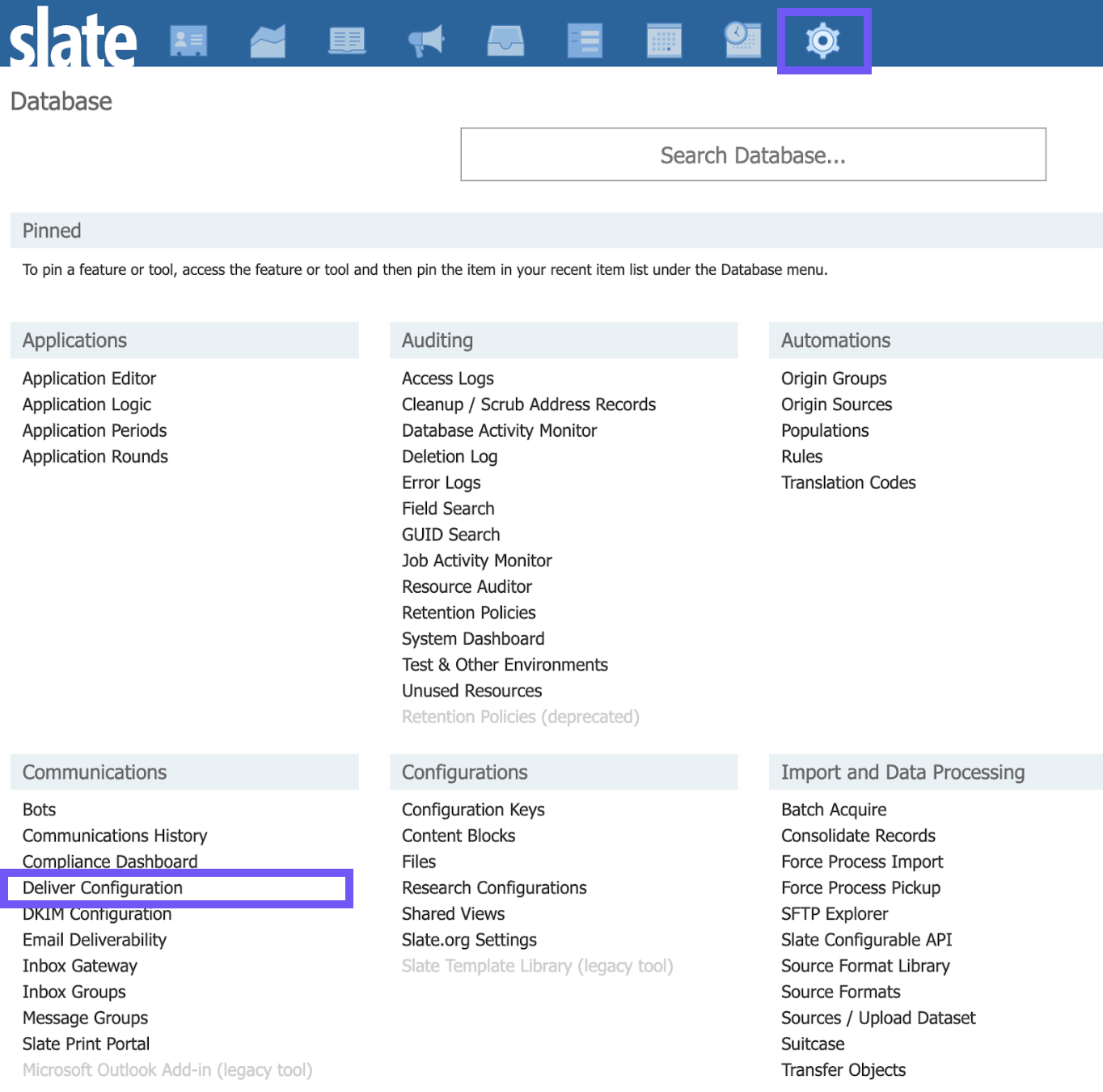
Click Add Account.

Select Scoir from the drop down menu and click Continue.
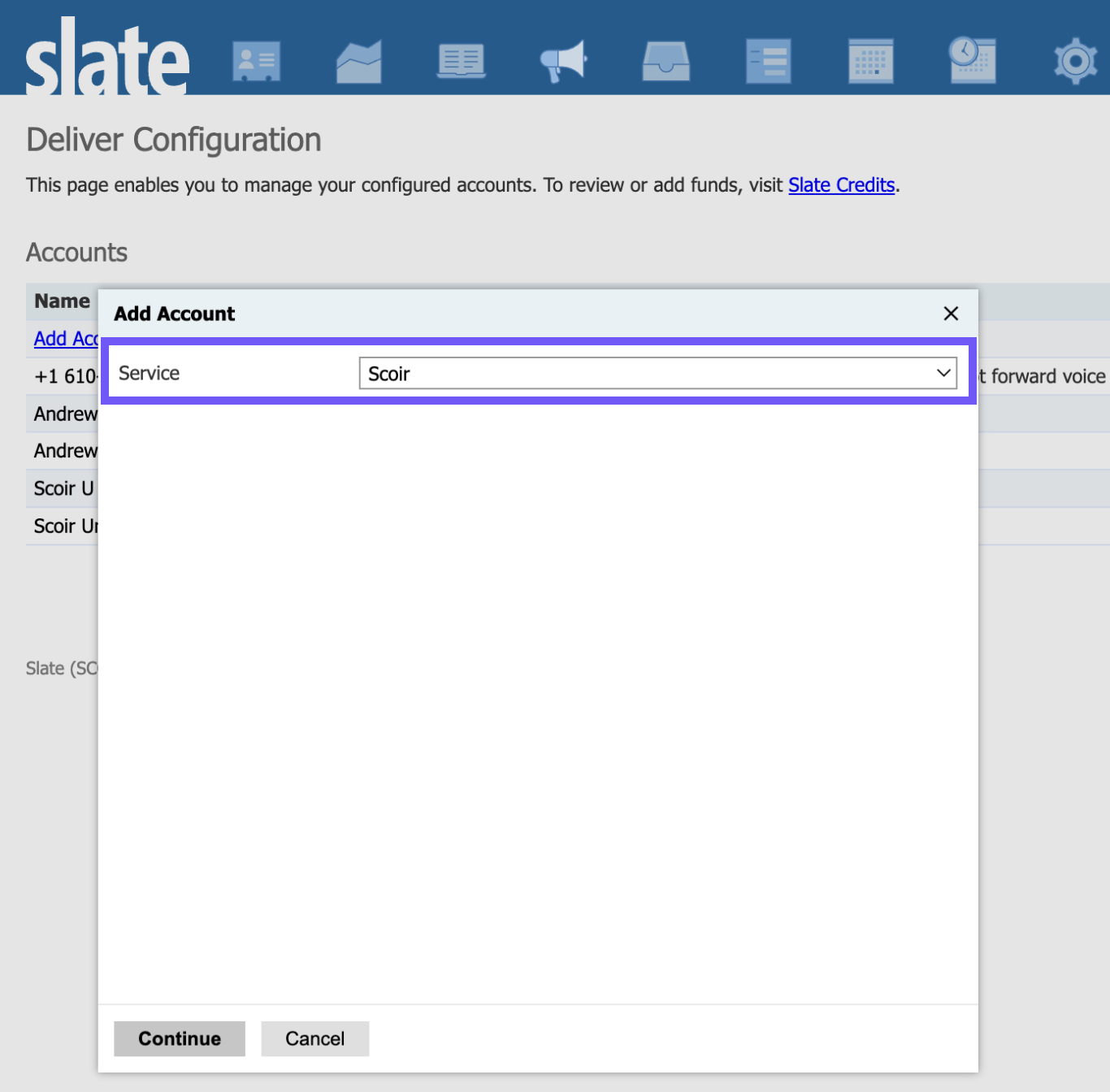
Give your account a name, like Scoir. Then select the appropriate Scoir Account from the drop-down menu.
Select the user who will be the point of contact for Scoir messaging. This can be the same person who is activating the integration, or someone else.
Click Save.
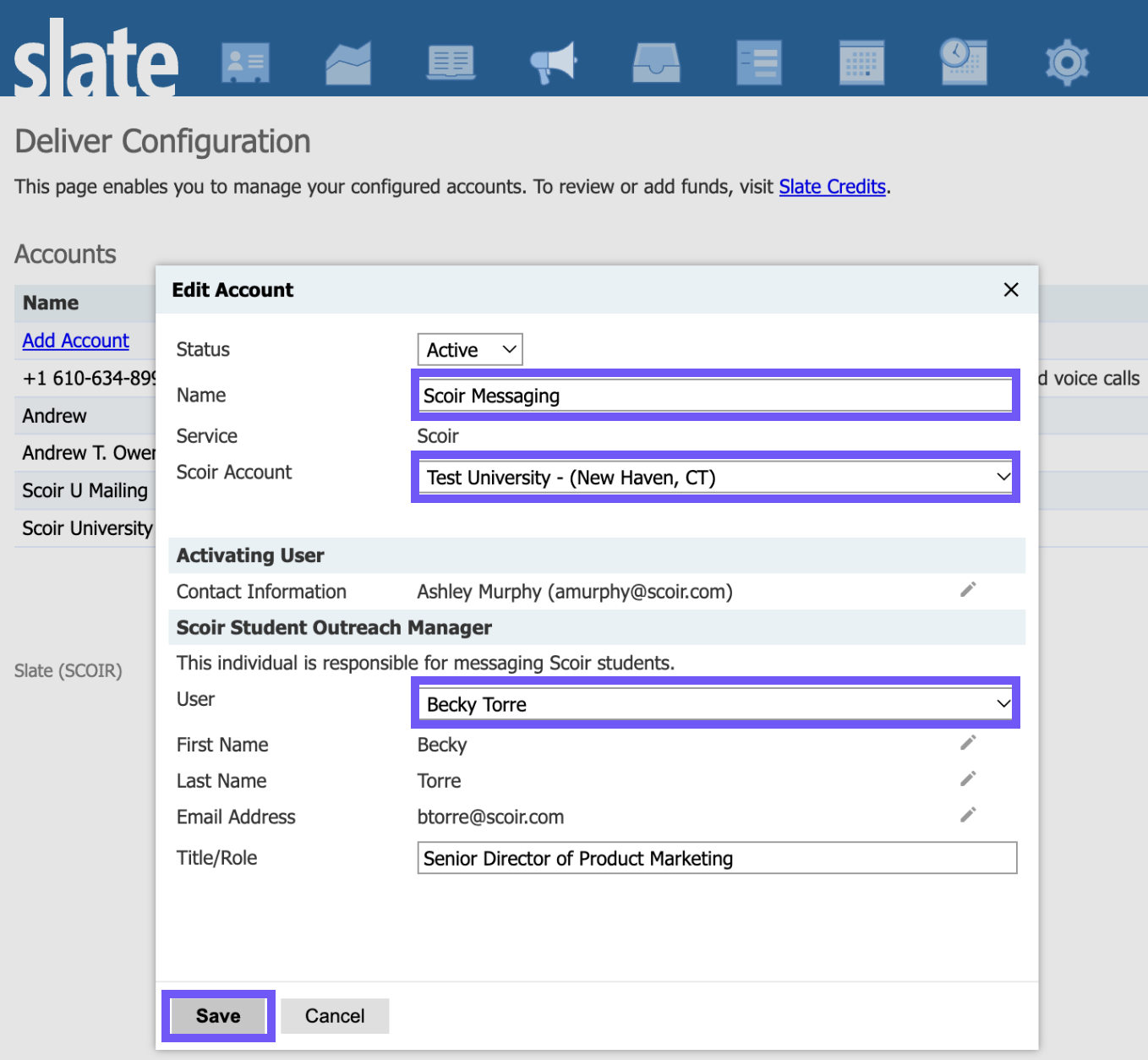
Activating the Account in Scoir
After you’ve added your Scoir Account in Slate, you'll be prompted to click through to activate the account in Scoir. This step turns on the flow of data from Scoir to Slate via the Scoir Audience source format; however, you’ll still need to activate the source format to begin receiving the data (see the next step).
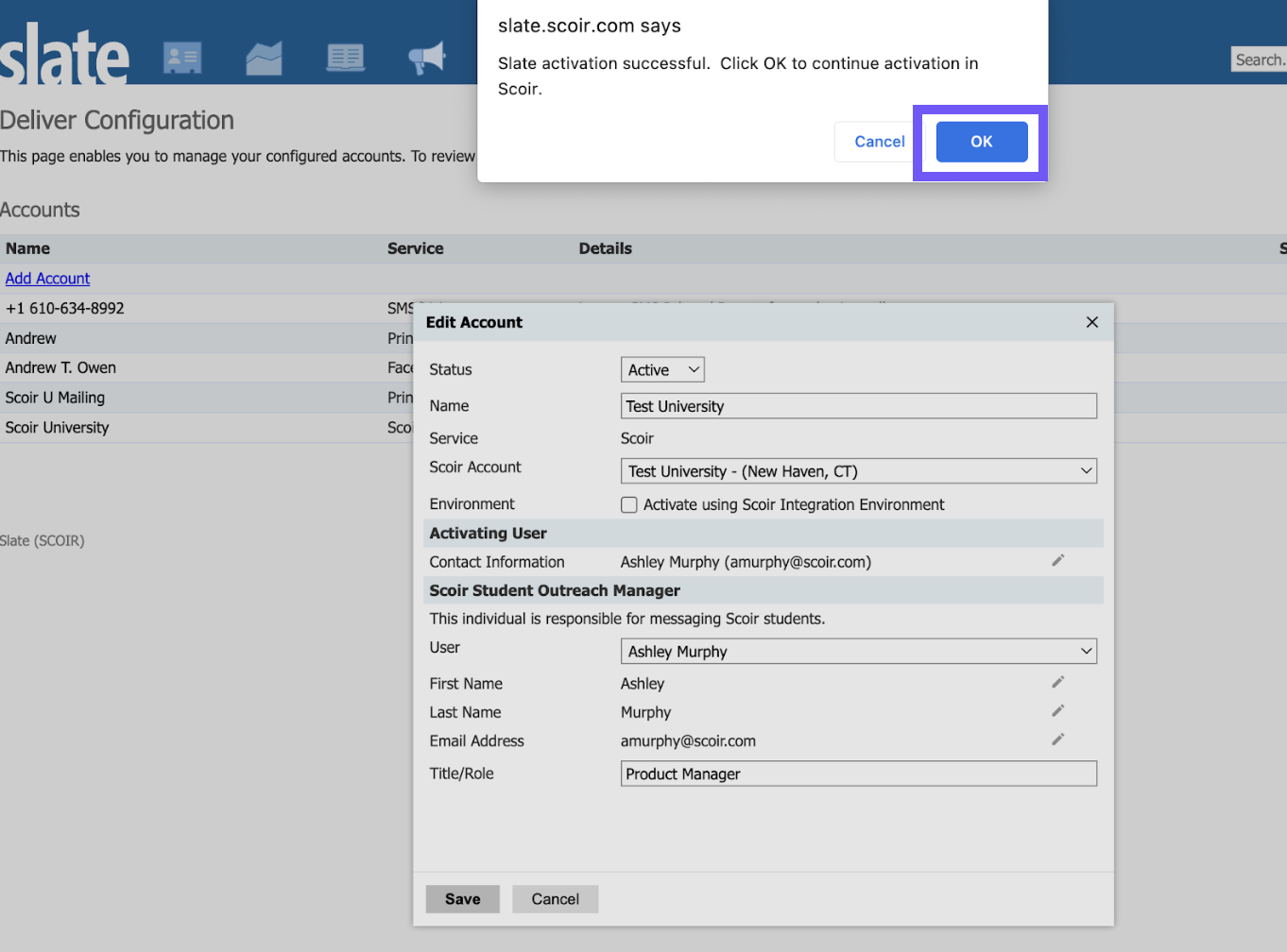
If you’re not already a Scoir user, you can follow the steps on the screen to Request Account.
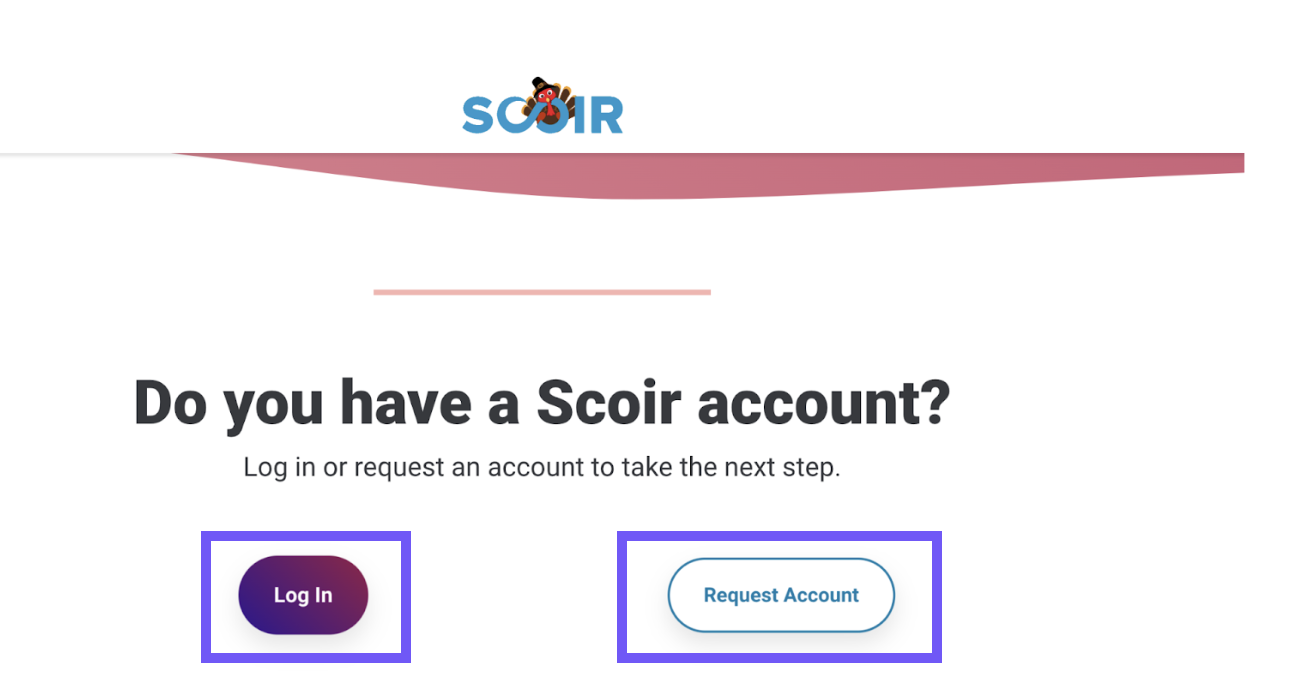
Once logged into Scoir, click the Enable Your Follower Import button in Engage > Integrations.
Click Continue.
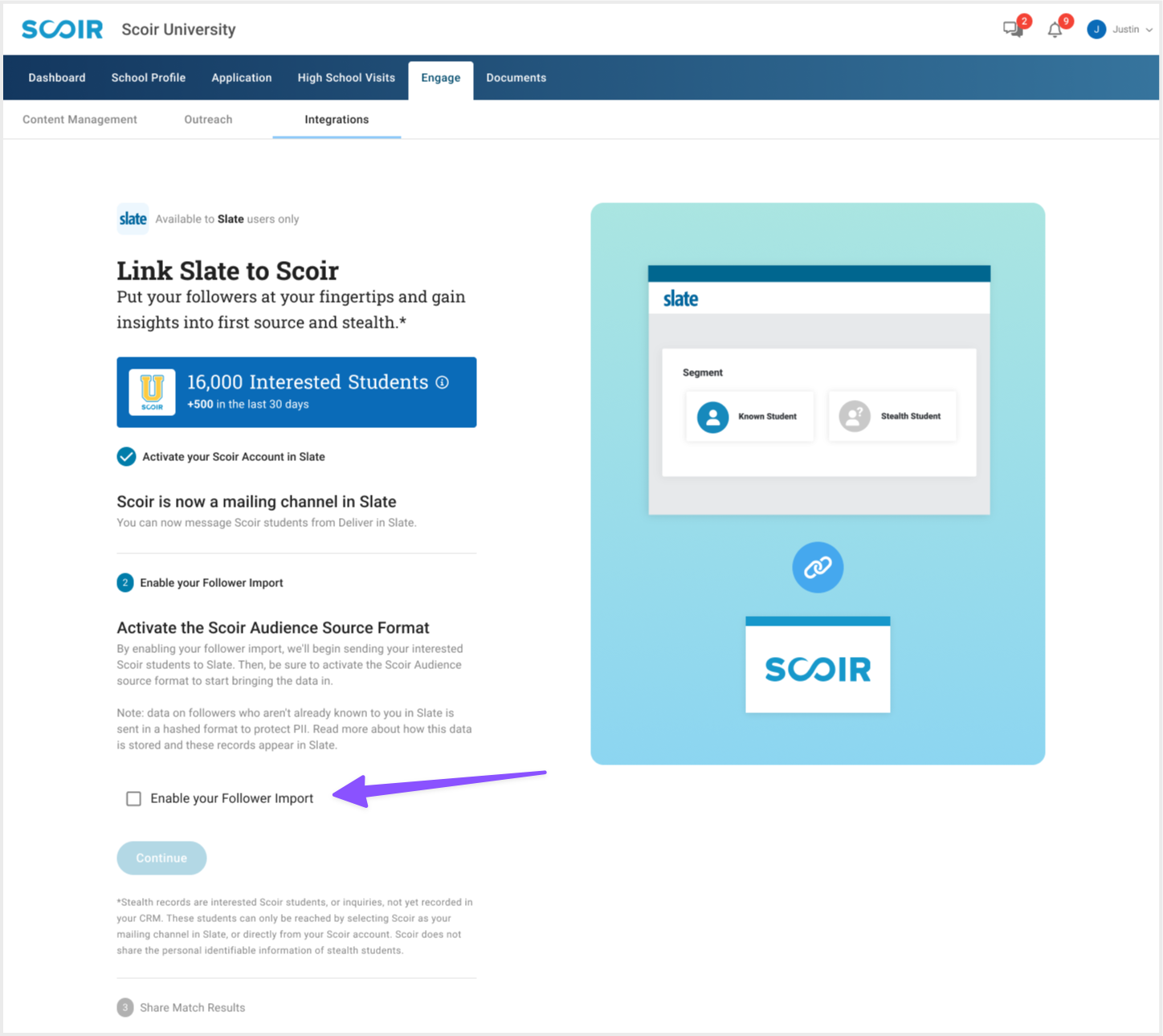
If you happen to land on this page before you’ve added your Scoir Account in Slate, you’ll be prompted to go back to Slate to add the account first.
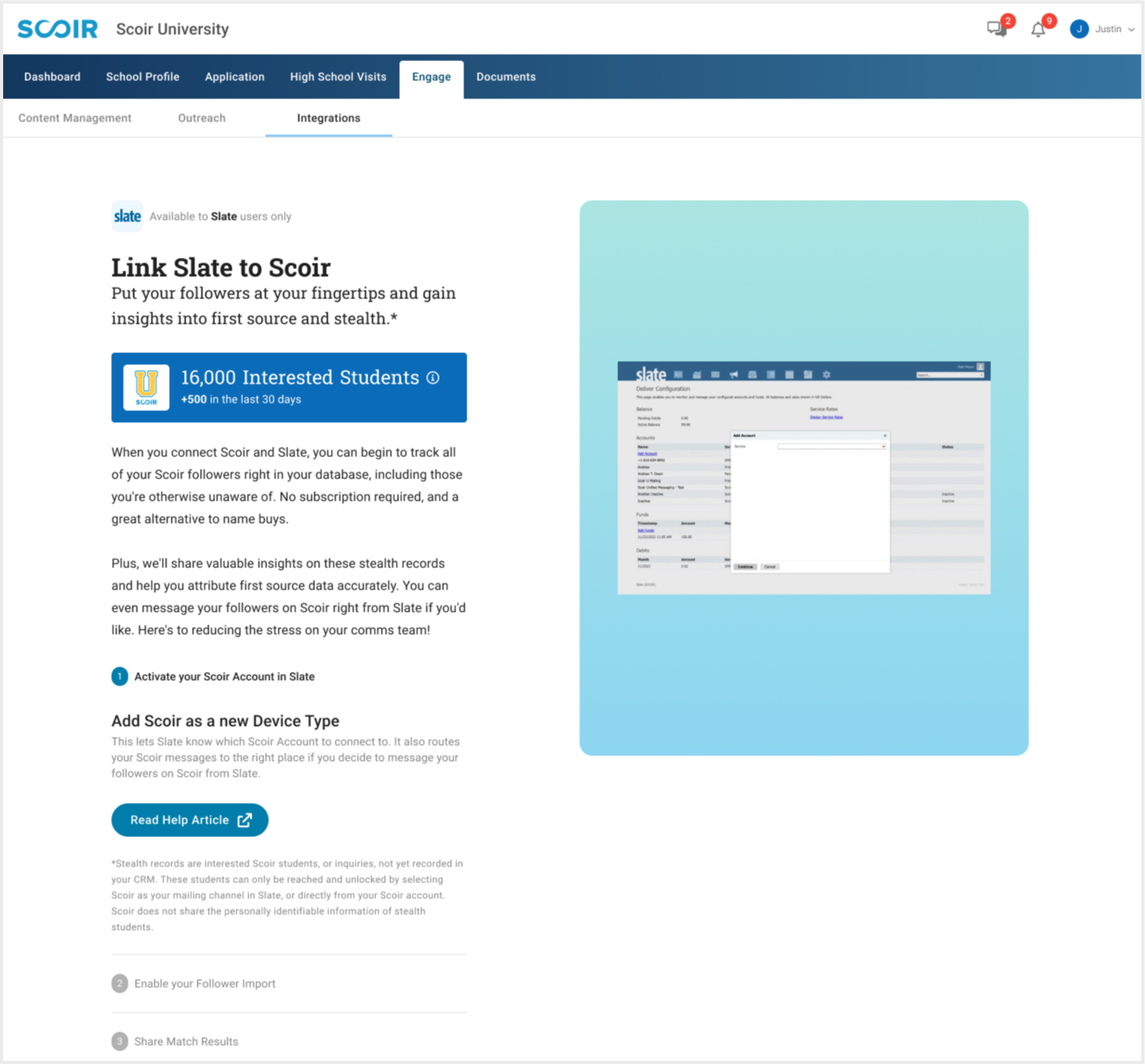
Mapping and Activating the Scoir Audience Source Format
The Scoir Audience source format is the automated import that contains information on all of the students who have expressed interest in your college in Scoir. When you add the Scoir Account in Slate and activate it in Scoir, the source format is automatically added to your database with some pre-set default mappings.
Navigate to Source Formats in the Database.
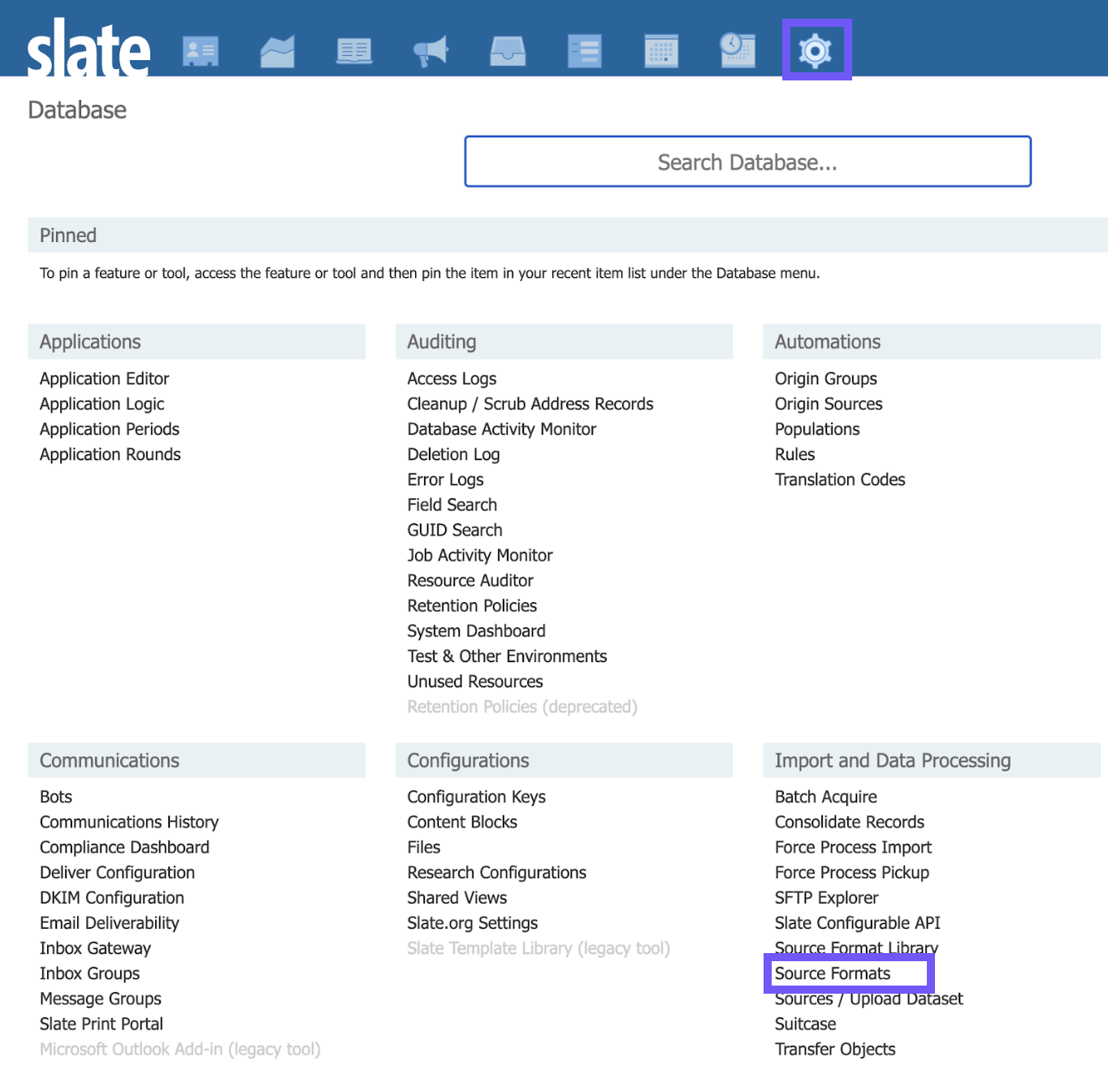
Click on the Scoir Audience source format.

Click Remap.

The pre-set default mappings are shown below.
The ‘scoirID’ and ‘scoirCollegeID’ source fields are brought in as a new Device on the person record. This Device is one way you’ll be able to identify your Scoir inquiries in Slate, and also serves as the delivery mechanism for Scoir Messages, similar to an email address for an email message, if you decide to send Scoir messages through Slate.
The ‘engaged’ source field is the field that sets whether the Device value is active or inactive. If one of your interested students decides to unfollow you in Scoir, then the integration will bring in that update as ‘engaged’ = ‘false’ and the Device Priority will be set to Inactive.
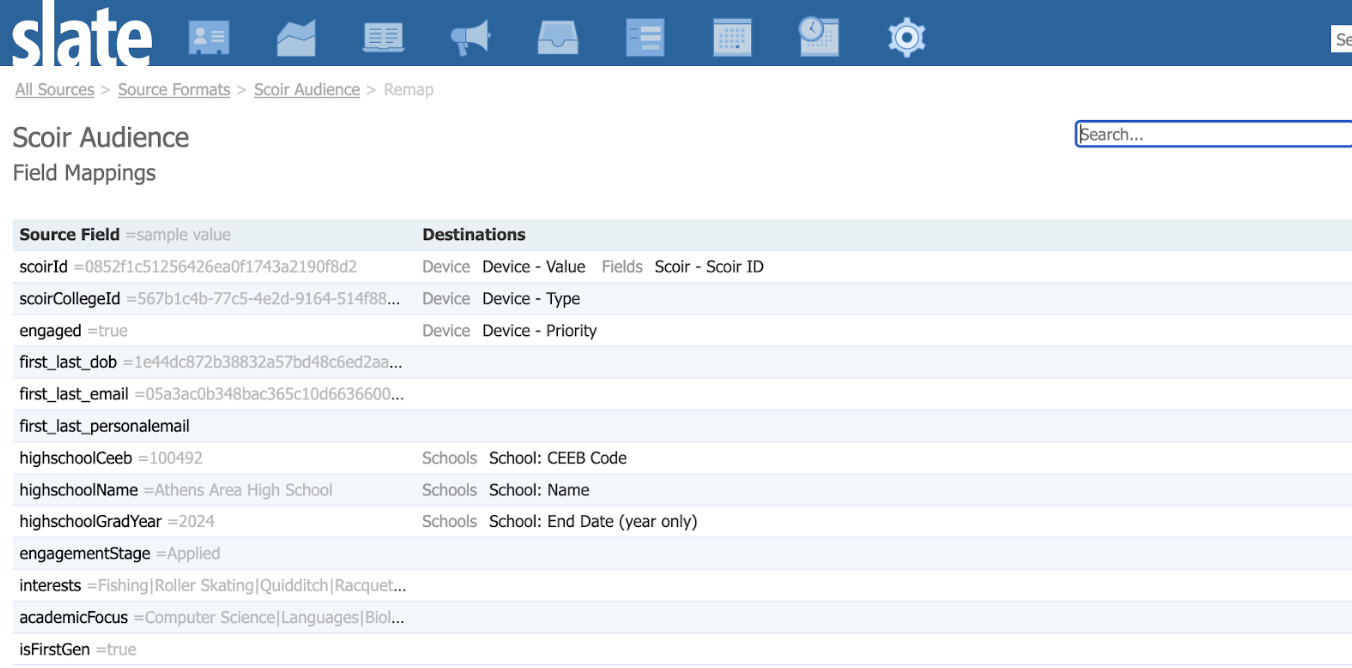
If you do not already have a custom field for Scoir ID, you will need to create one and return to the source format Field Mappings to map this field. The custom field must be person-scoped, free text, and unique for merging.

• scoirID
• scoirCollegeID
• engaged
For matching to work as intended, scoirID must be mapped to your custom Scoir ID field in addition to Device Value.
The source file will also contain an ‘engagementStage’ value for each record. This value lets you know whether the student has indicated in Scoir that they are following, planning to apply to, or have already applied to your college.
You will need to create a custom field and custom prompts in your database to store Scoir Engagement Stage.
Scoir Engagement Stage prompt values are Following, Applying, and Applied.

The Scoir Engagement Stage field should be person-scoped and a single-value type.
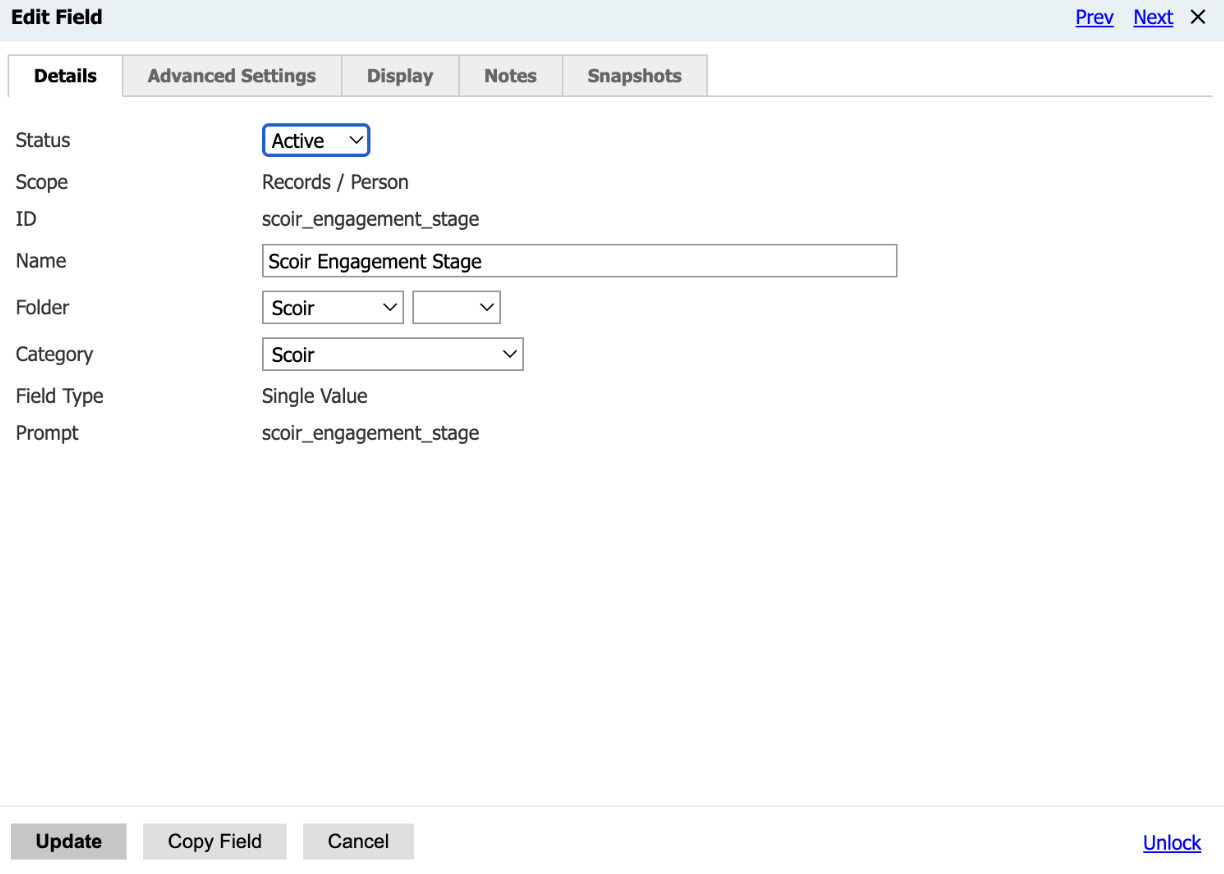
Navigating back to the Scoir Audience source format, you will then be able to update your source format mapping with the newly created Scoir Engagement Stage field and prompt values.

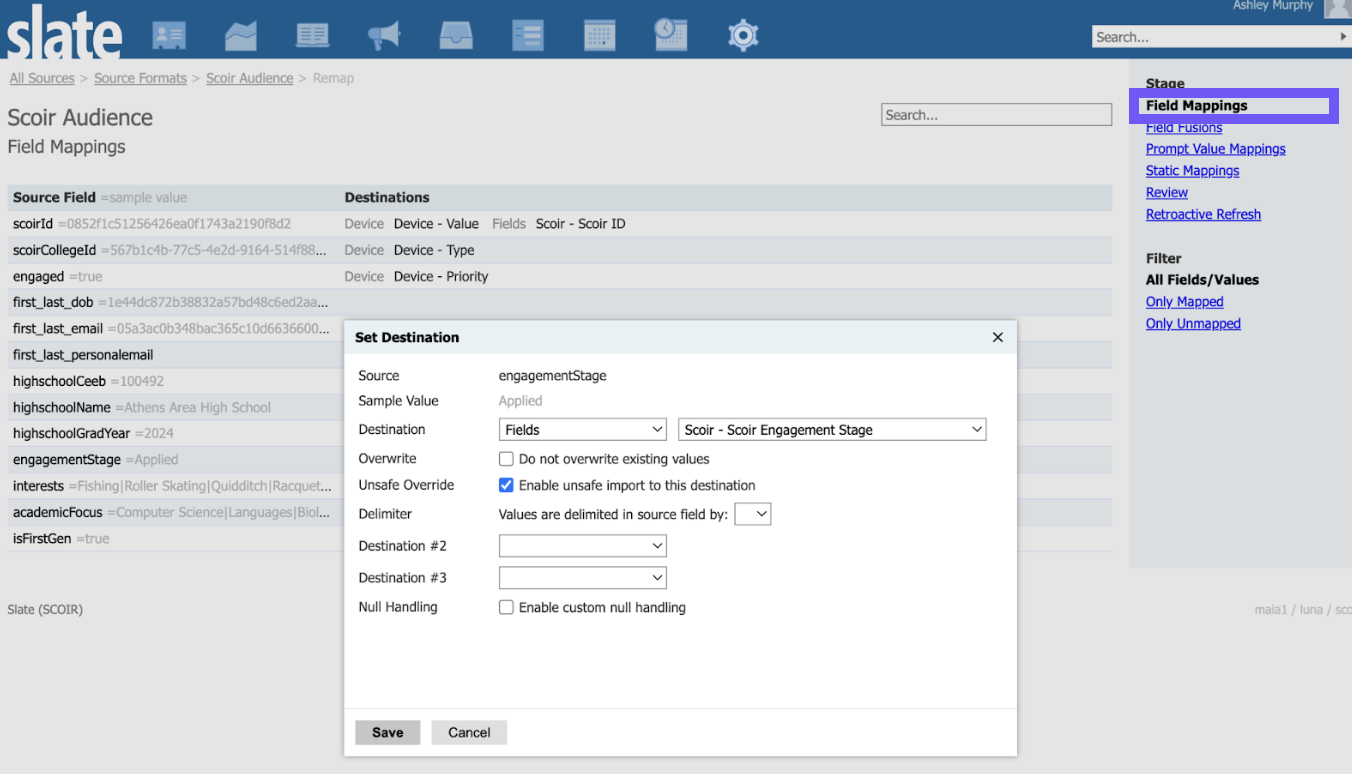
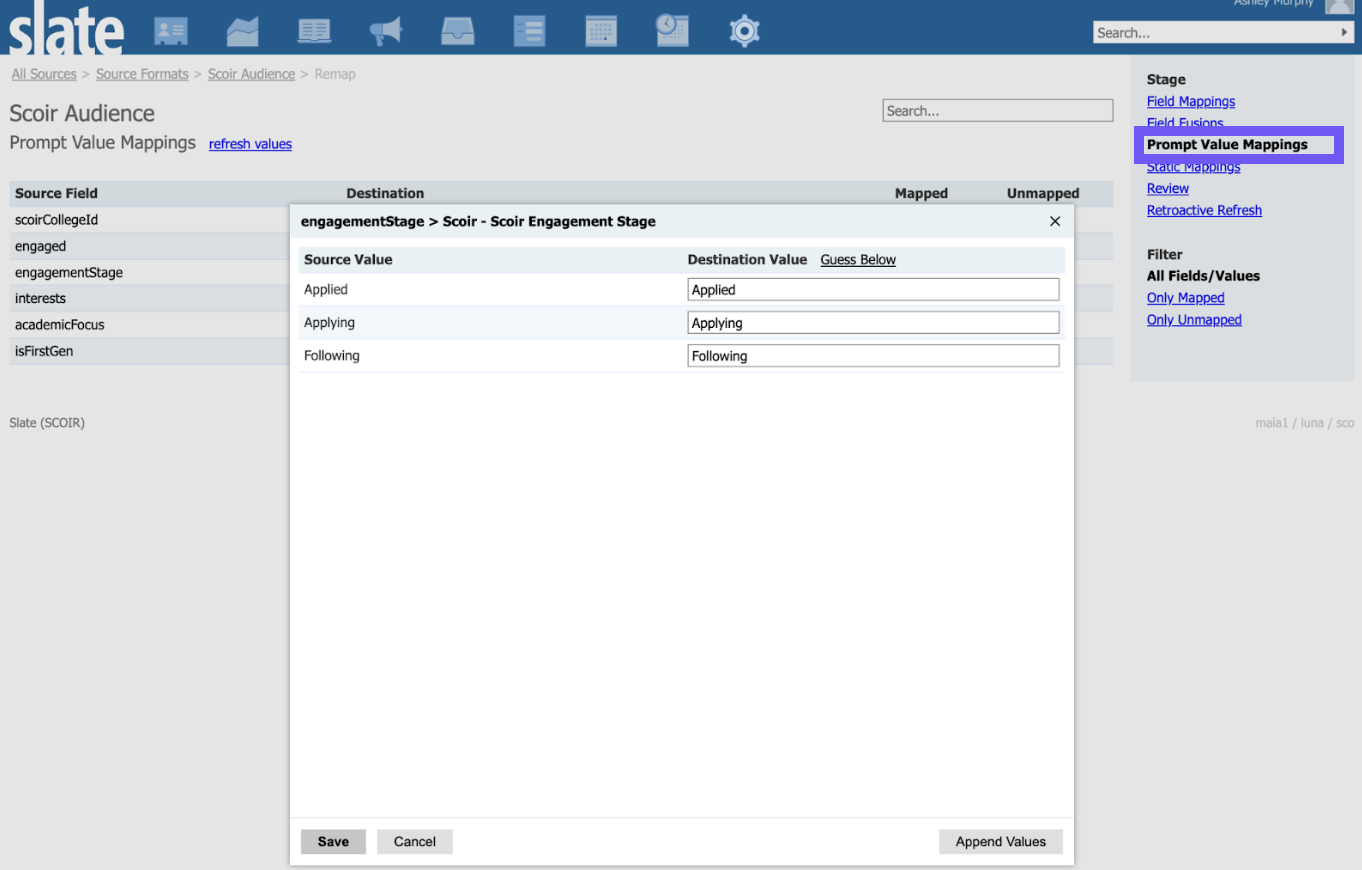
You can Append Values and add each of the Scoir Engagement Stage source values to map each to the appropriate destination value as shown in the mapping example above.
Since your followers, including stealth, are true hand-raisers on Scoir, we recommend including a static mapping of the Person Status so that new records are created as Inquiries instead of Prospects.

Then, activate the source format by selecting Active as the status and marking the Remap Active status to Active. It’s critical for the Remap Active status to be Active when activating the source format to avoid records landing in Consolidate Records.
Once activated, imports will be sent from Scoir to Slate overnight as new followers are added or existing followers are updated.
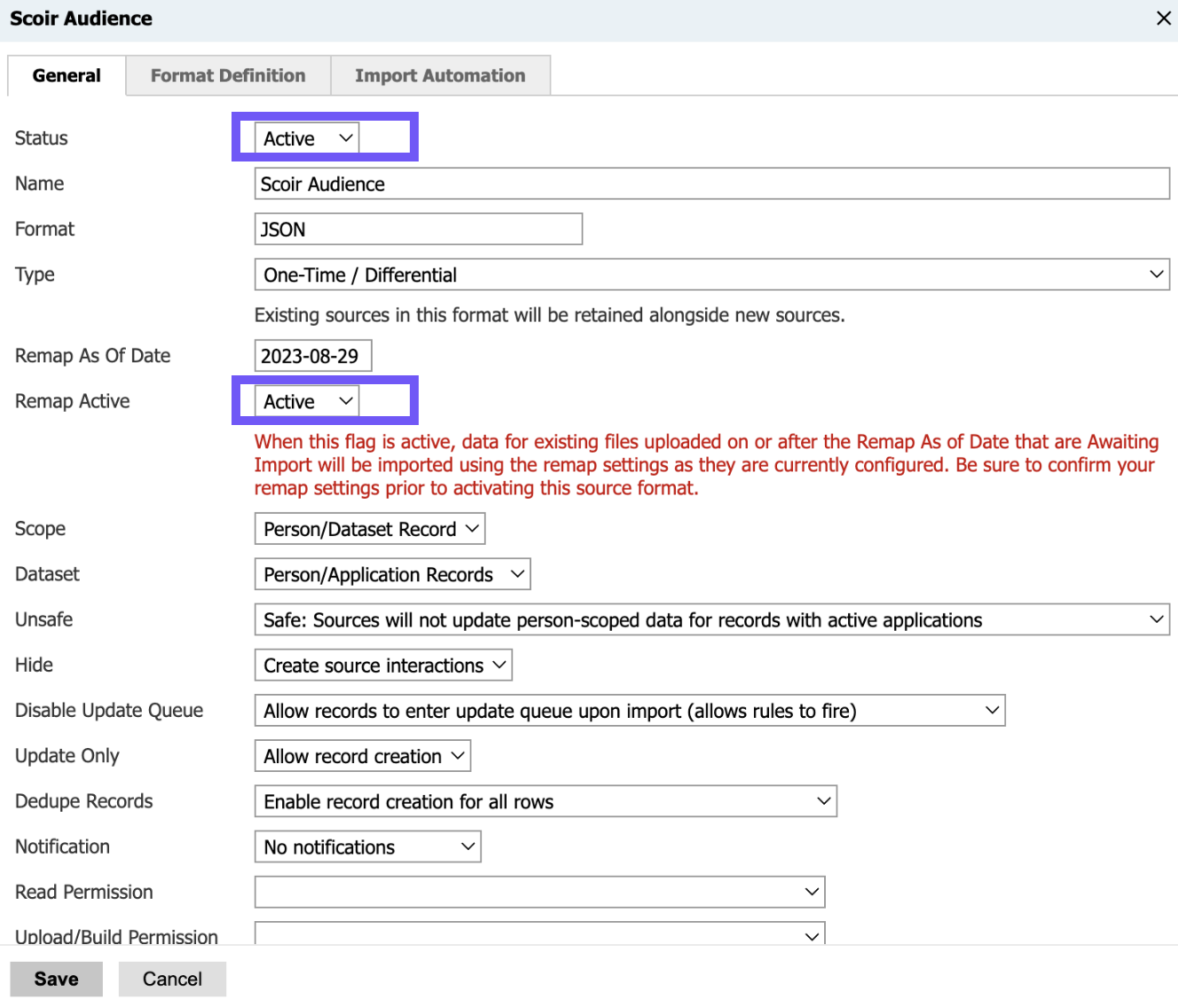
Record Matching and Creation
In addition to Scoir ID, the import will also look to match to an existing record based on the combination of First/Last/DOB or First/Last/Email.
Personal information is sent in a hashed format to protect the student’s identity for any record not already known to you. Slate can read the data to identify matching records in your system, but the end user will not be able to decipher it in the file. This is because all of your interested students in Scoir are sent to you, including those who aren’t able to be matched to a record already in your database.
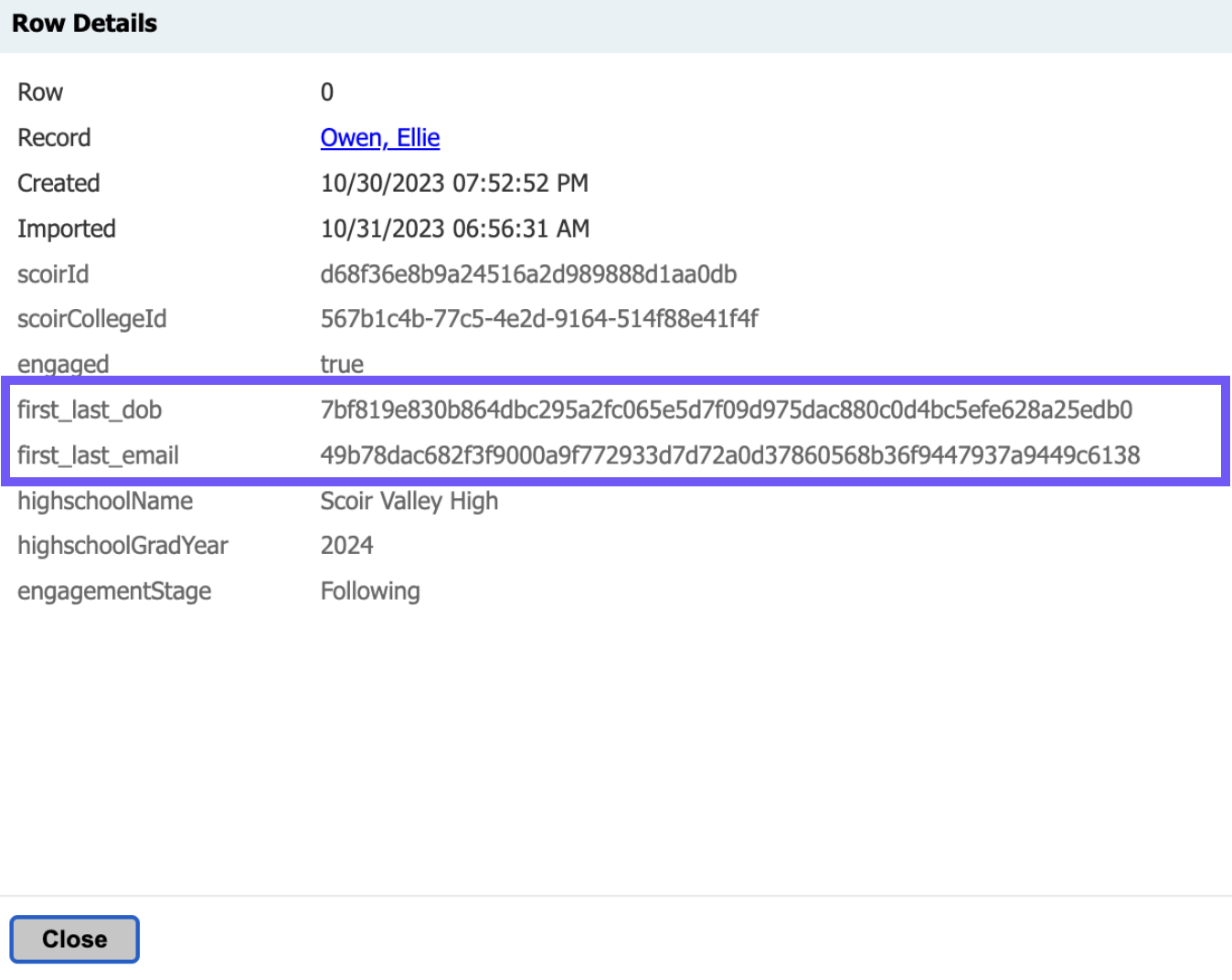
Note: The order of matching logic is:
- Scoir ID
- Email address + first + last hash
- First + last + birthdate hash
This means you’ll have records created by the import for prospective students previously unknown to you. These are created with the name “unknown.” A Scoir ID and a Scoir Device are attached to the record to facilitate identification of Scoir followers and Scoir Messaging, but no other personal information is provided.
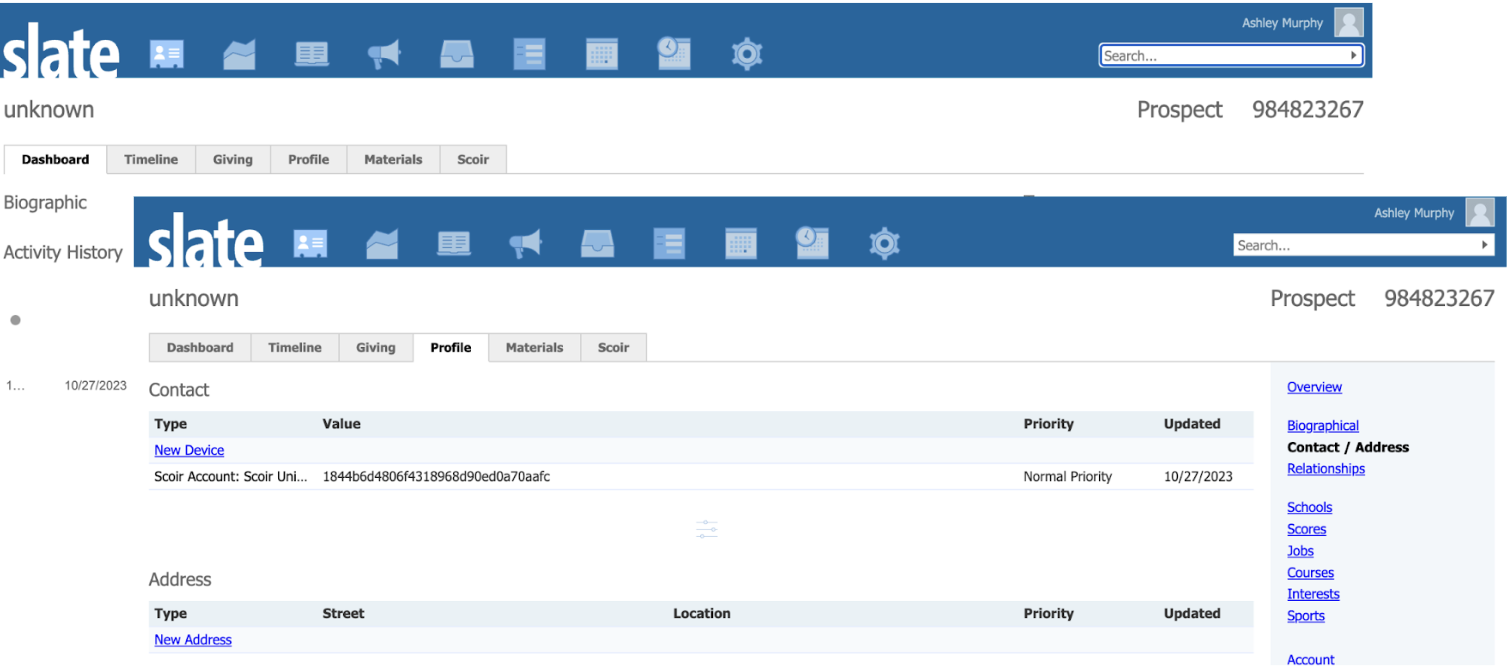
When an unknown person record is created, Slate will store the hashed values for those unknown records, which can then be used for matching purposes by future regular known-value imports and form submissions, and to allow them to then become known records.
Unlocking Scoir Audience Insights
Key to the integration is the ability for you to share information back to Scoir about your Scoir records so that Scoir can provide a more detailed engagement analysis, including accurate first source attribution and demographic insights on your stealth records.
Data sent includes Deliver Account ID, Person ID, Person Created Date, and a Stealth/Known indicator.
Add the Scoir Audience Match Results query from the Slate Template Library.

Navigate to the query and click Edit Query.
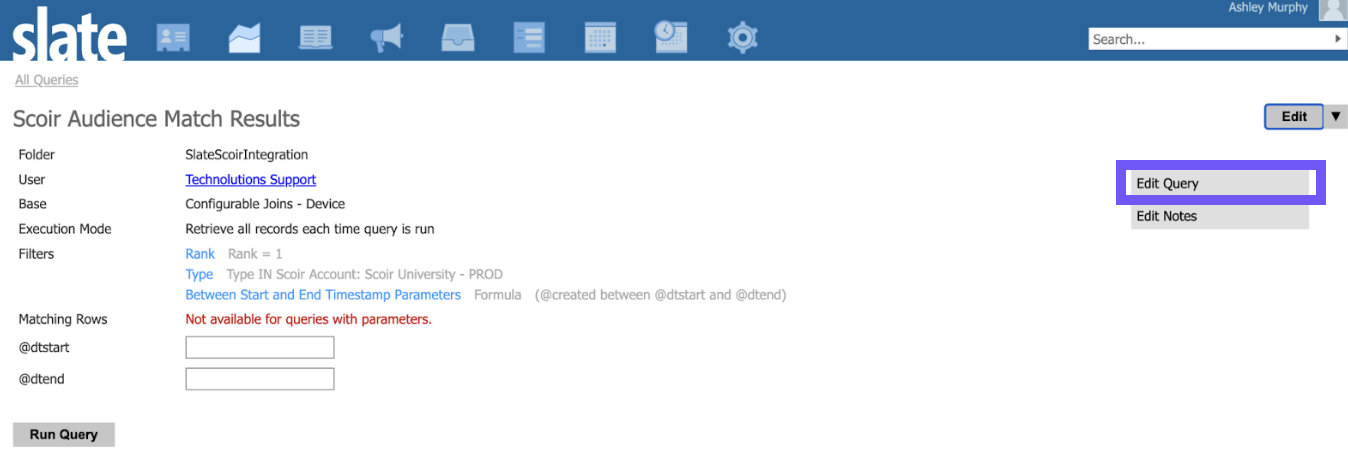
Click on Edit Permissions.
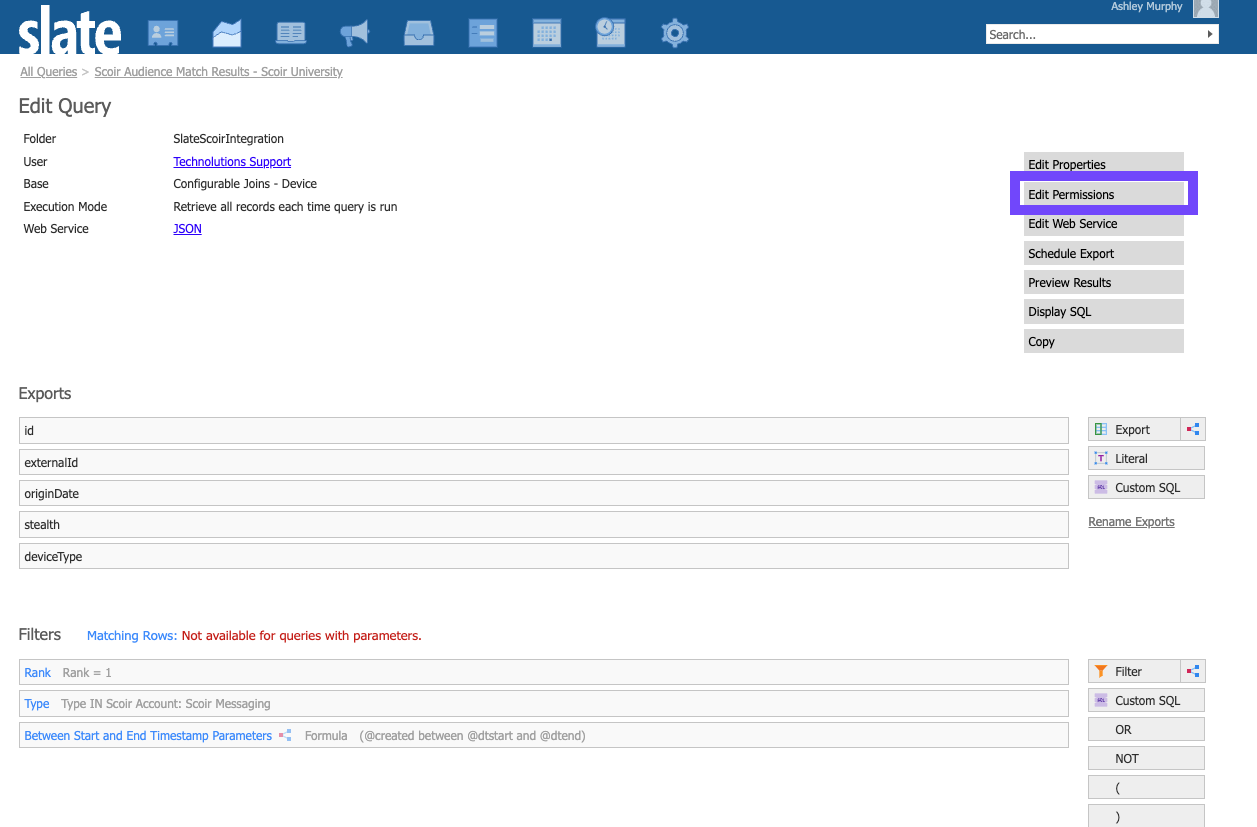
And Edit/Add a Grantee.
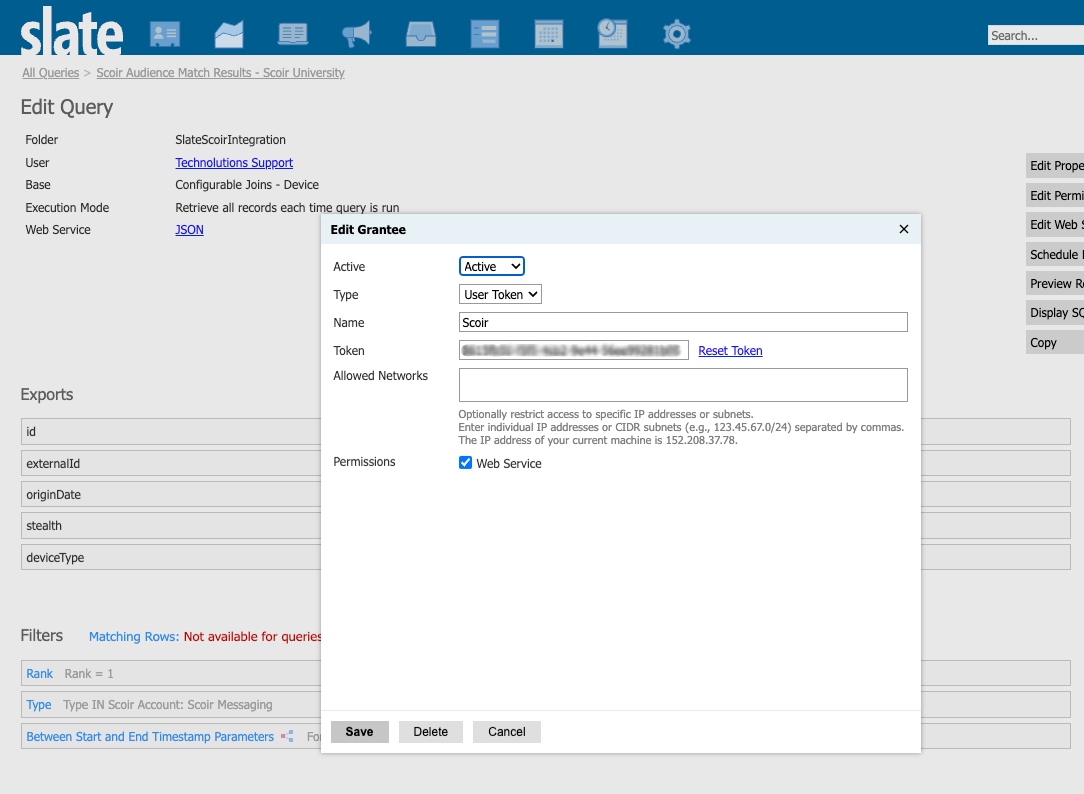
Click on the Web Service link.

Select User Token - Scoir from the Service Account dropdown and copy the complete URL that’s displayed in the box.
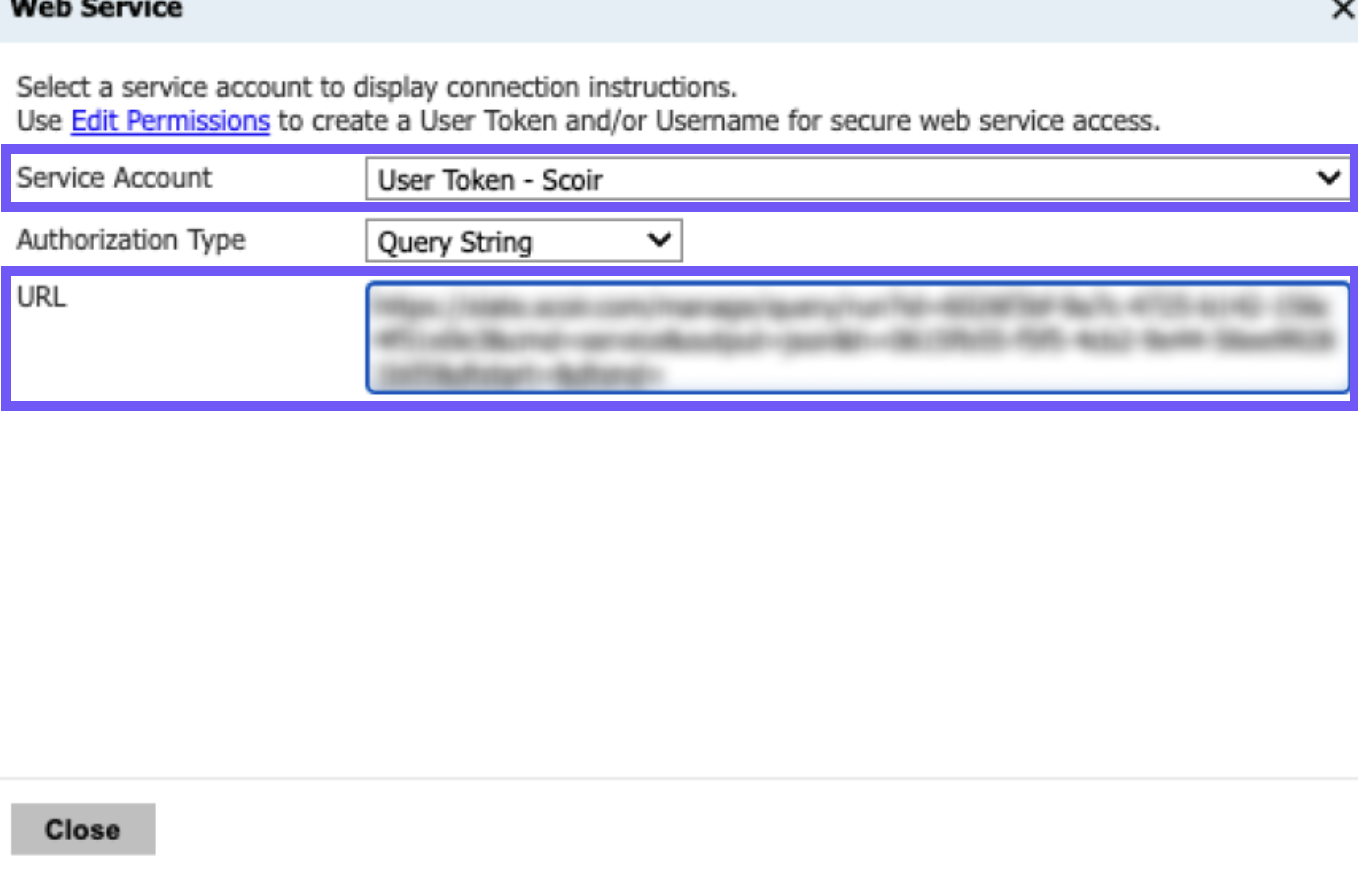
Return back to your account in Scoir, and paste the URL into the box as shown below. Click Unlock Stealth Insights.
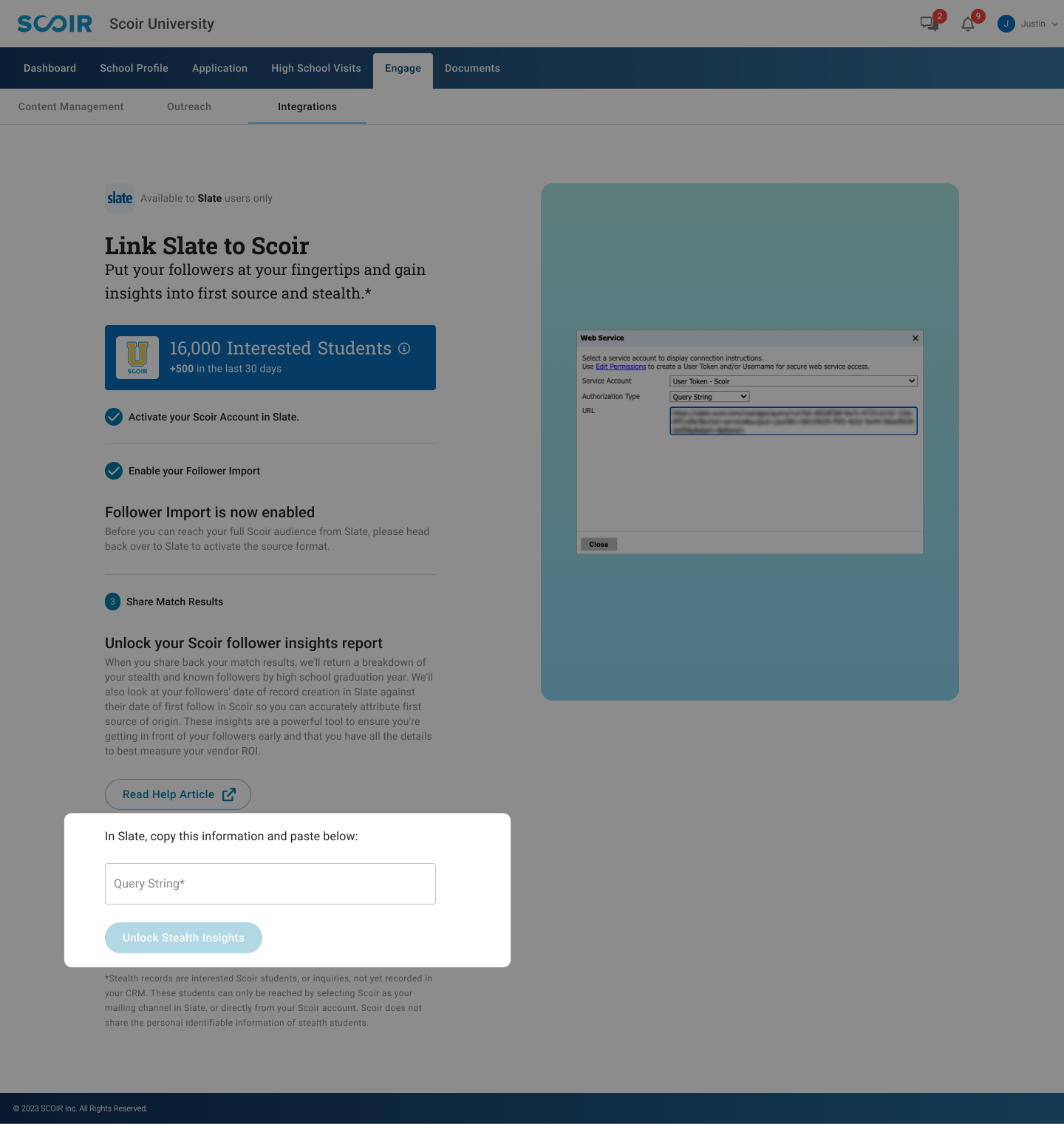
Once completed, your point of contact at Scoir will send your institution’s Scoir Audience Insights Report.
Working with Scoir Data in Slate
We’ve created a number of pre-built filters and exports you can use to identify and track Scoir inquiries in Slate. You can import these into your Query Library via this Suitcase ID:
bb84b23b-343e-4d6f-8485-9c9a32cdb9f8:sco
You will need to configure the “Scoir Account Device Type is Active” filter to select your Scoir Account Device Type and Scoir ID to your custom Scoir ID field.
Creating a Scoir Message in Slate
The Scoir Audience integration opens the opportunity to send Scoir messages right from Slate. This is particularly useful for colleges that aren’t yet using Scoir’s full suite of tools but want to engage with their Scoir students.
Navigate to Deliver and click New Mailing.

Name your mailing and file it in a folder as with other mailings. Select Scoir as the Deliver Method. Click Save.

Click Edit Recipient Lists to specify who you want to send the mailing to and to pull any exports you’ll use as merge fields in your message. See Messaging Stealth Records
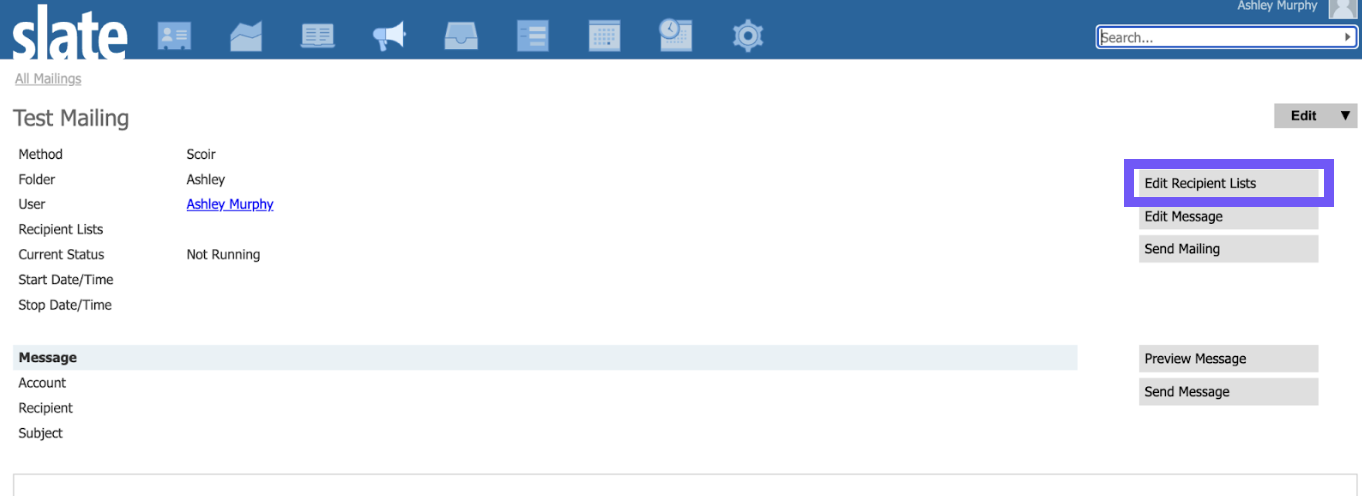
Click New Query.

At a basic level, any record with an active Scoir Account Device Type can be messaged in Scoir via Slate. To get started, you might simply filter on the existence of an active Scoir Account Device Type to identify the records in your system that are eligible to be messaged in Scoir.
You might also want to identify and distinguish between the followers that were matched to records already in your system vs. the stealth followers that are otherwise unknown to you. See the Working with Scoir Data in Slate section above for help with the use of filters when building a recipient list.
When configuring your recipient list query, Scoir Recipient must be an included export. This is the Scoir Account Device that will be used in the ‘To’ field when building your message. You may wish to include additional exports if you plan to include merge fields in your message for personalization. See Messaging Stealth Records
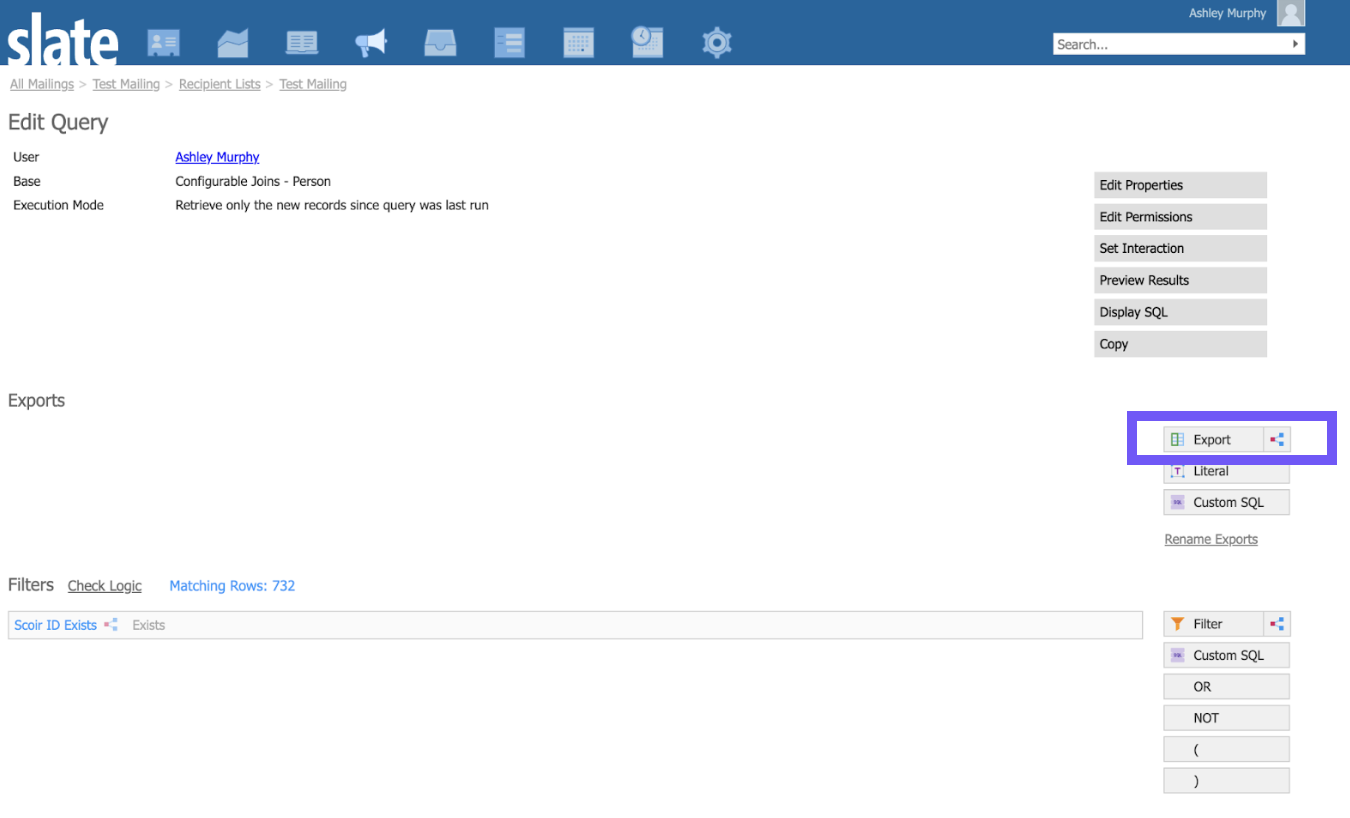
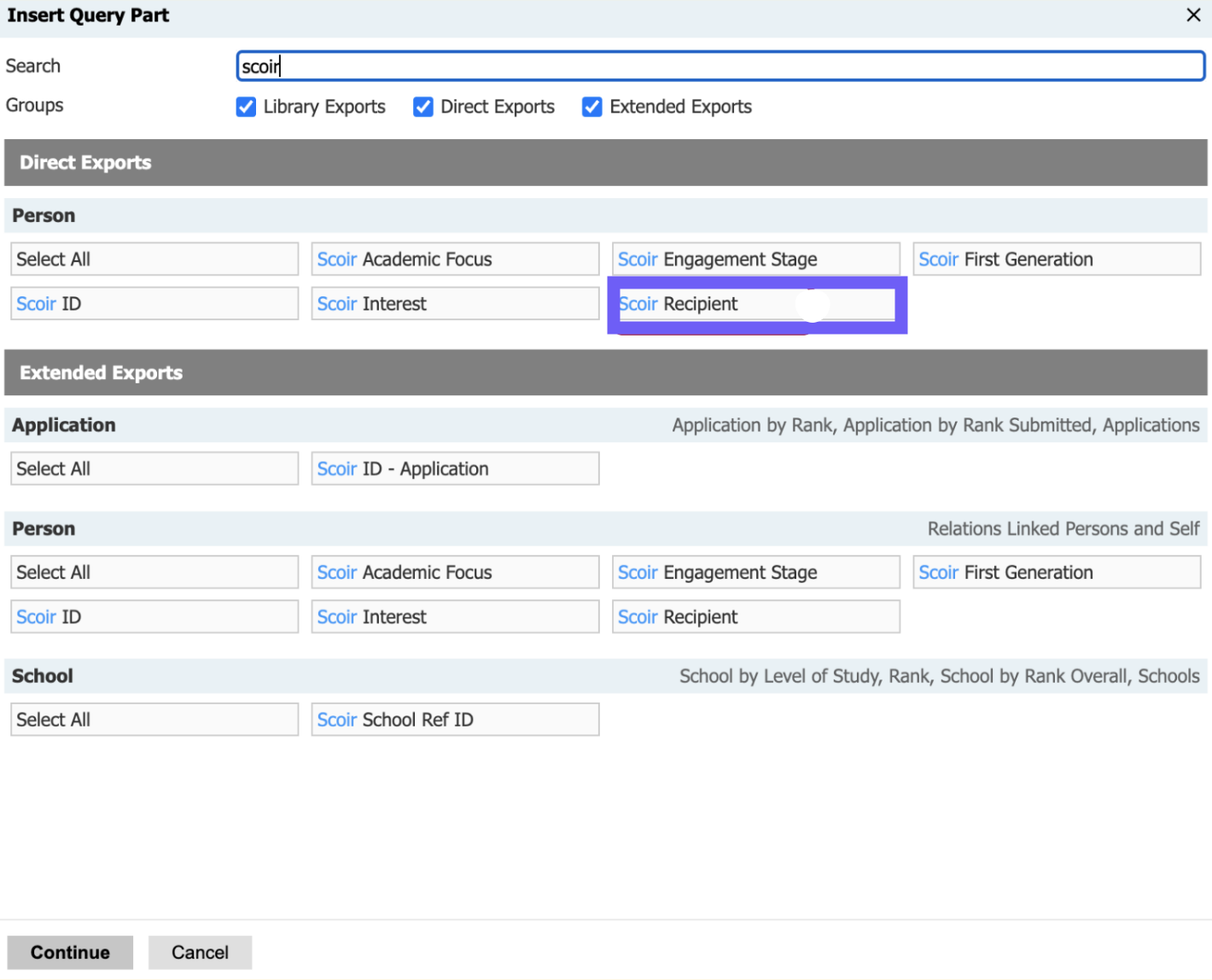
The Scoir Recipient export will require configuration. This is because some colleges may have multiple Scoir Account Devices if they manage more than one campus in the same instance of Slate. Everyone must specify the Scoir Account Device for the Scoir Recipient export even if you only have one.
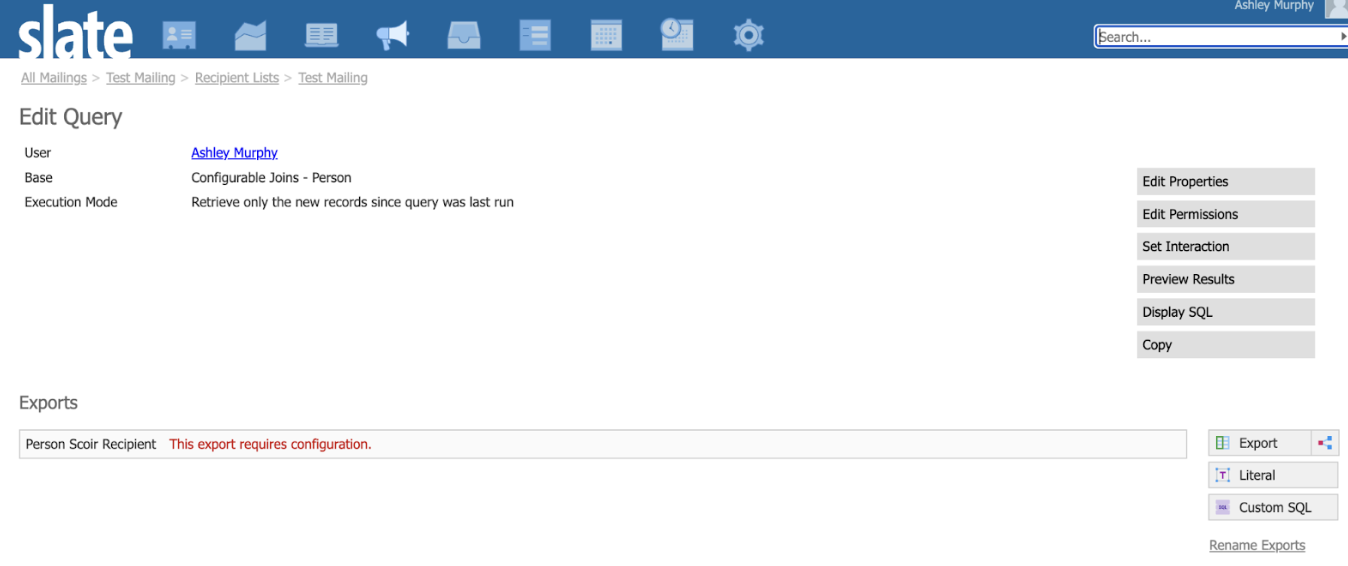
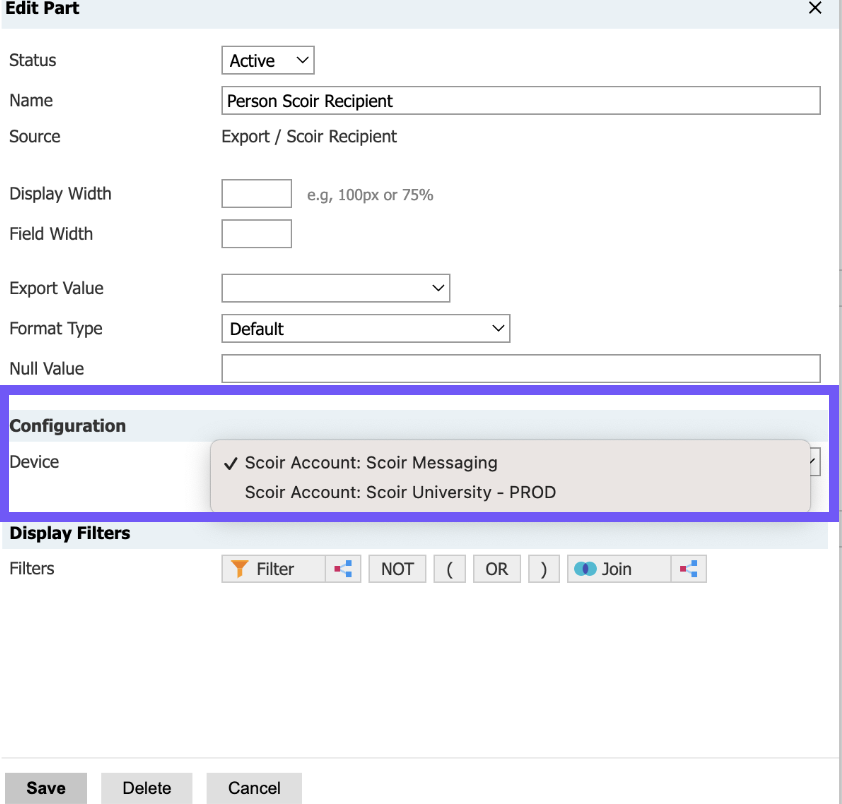
After you’ve configured your recipient list query, you can begin drafting your message.

You’ll find a simplified message editor that supports all of the capabilities for building a Scoir message. The Recipient field is a drop-down menu that will include each Scoir Account Device included in your recipient list query exports. The Account you choose corresponds with the Scoir profile you wish for the message to be sent from. Most colleges will only have one.
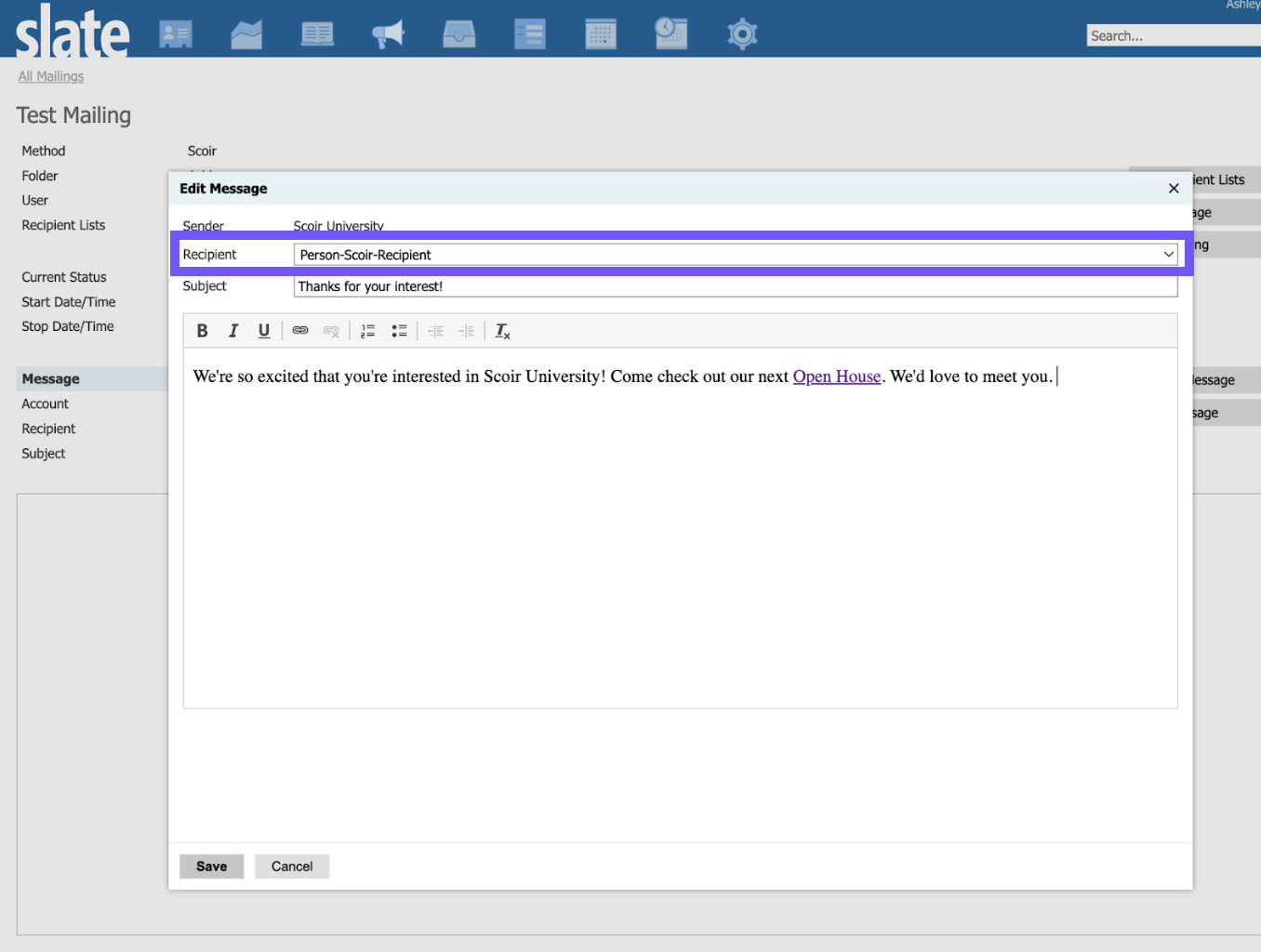
If you included additional exports in your recipient list query, the message editor does support the ability to add merge fields. See Messaging Stealth Records
Insert a pair of double brackets anywhere in your message where you wish to insert a merge field. For the subject line, you must manually type in the brackets and name of the field export as it appears in your recipient list query. Click Save.
When you go back into the message editor, you’ll be able to double click on each set of brackets in the message body and select your merge field from the dropdown.
Messaging Stealth Records
Use caution when including merge fields in messages that include stealth record recipients. In most cases, you will only know the Scoir ID, high school information, and Scoir Engagement Stage for these students. Including merge fields for data not available for a record will result in blank content being displayed in the message for that student.
Inserting a Message in a Campaign
Scoir messages can be built as stand alone messages or be included as part of your existing campaigns. To include Scoir messages in a campaign, simply insert the message in the mix wherever you’re interested in utilizing this channel. It’s not necessary to create separate campaigns for Scoir followers. Folding these messages into existing campaigns reduces the risk of sending duplicate or overlapping messages to the same students.
Questions?
Email Scoir Product Manager and Slate expert, Ashley Murphy with any questions about the integration: amurphy@scoir.com.